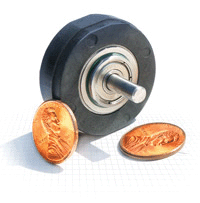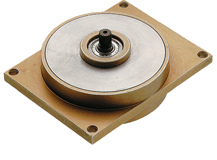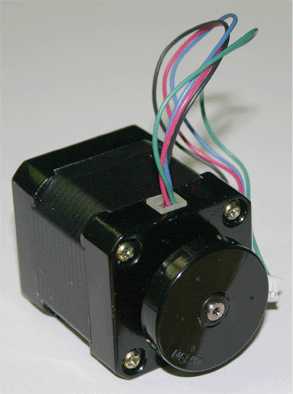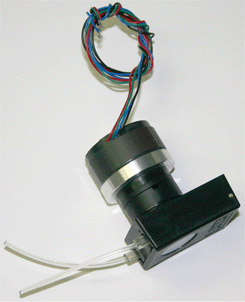By Mindy Lin Cheng, Application Engineering Specialist and Belal Azim, Marketing Specialist, Lin Engineering Santa Clara, Calif.
Whether the medical product is a systolic pump or a Petrie dish, evaluate the following step motor characteristics:
1. Small package
2. High accuracy
3. Smooth motion
4. Low noise
5. High quality & reliability
1. Small package
In terms of size, step motor manufacturers adhere to various NEMA frame sizes. These physical sizes range from the miniature NEMA 8 to the massive NEMA 42. For most medical applications, mounting space is a critical issue, so the less space the motors require, the better. Although there are some drawbacks to selecting a smaller motor (such as less torque), it is the proper procedure for most applications. The NEMA 8, for example, measures a mere 0.7-in. square while the NEMA 34 measures 3.3-in. square.
With many choices available for selecting the size of a step motor, one factor to keep in mind is that the NEMA frame size dimensions are an industry standard and cannot be easily altered. The length and thickness of the motor, however, can vary from manufacturer to manufacturer. For example, the 3609Z motors are only 0.47-in. thick. This 0.9° step motor is one of the thinnest motors in the industry. When the application requires that the product be designed to accommodate the motor, this same series of steppers come in a round or modular type of housing that makes it easier to fit a custom enclosure.

Lin Engineering’s 3609Z step motor is only 0.47-in. thick and is one of the thinnest 0.9 motors in the industry. It maintains ±1.5 arc minutes of error under 1/64 step microstepping, compared to the industry average range of ±4.5 to ±18 arc minutes.
2. High accuracy
Where the issue of accuracy is concerned, it is safe to say that several medical applications require extremely high accuracy step motors. For example, a laser eye surgery machine would be in great danger if the motors and machinery were not accurate enough during a surgical process. Step motors rotate in terms of degrees, and all of them contain some type of step error. Therefore, it is a matter of choosing one that has the least amount of error for the application. Step error is measured in miniature increments of arc minutes where one arc minute equals 1/60°, or 0.0167°. The industry average error for a 0.9° step motor is 4.5 arc minutes, or, 0.075°. Lin Engineering’s 0.9° step motors have an average step error of 1.5 arc minutes, or, 0.025°. Of course, the finer the step resolution of the motor, the more accurate it is. Generally, step motor manufacturers offer 1.8° and 0.9° increment step motors, and at least one company offers 0.45° increment step motors in a NEMA 17 package.

The 3609 step motor also comes in a modular type of mounting which lets engineers design their own custom, space-efficient housing
Step motor accuracy lies in the design and manufacturing process. When selecting a step motor, ask the manufacturer about its six-sigma process, or how many defects per million parts they encounter during production (DPMO Defects Per Million Opportunities). This will give you another benchmark upon which you can base your decision.
3. Smooth motion
Step motors have an advantage over many others because they can stop at any location that a program commands. However, as the name indicates, these motors move in distinct steps. In order to move one revolution, a 1.8° motor must advance 200 steps. Each step the motor takes requires a few microseconds to settle and it creates a slight oscillation before completely stopping. If these oscillations continue to add up with each step the motor takes, the motion can be jittery — not very smooth.
In choosing a step motor, it is often difficult to determine whether the motor will operate smoothly in the application. However, there are ways to create an environment for the motor such that smooth motion is possible. In most cases, motors are too powerful and produce jittery motion. Also, select a motor that has the proper amount of torque. Talk to an applications engineer to help eliminate any guesswork while choosing the motor. If the chosen motor turns out to be too powerful, decrease the voltage or current to decrease torque. In addition, mechanical dampers can be placed on the end shaft of a step motor to increase its weight and dampen the jittery motion.

This NEMA 17 step motor illustrates the use of a mechanical damper mounted on the end of the shaft to help reduce the step vibrations and resulting noise.
4. Low noise
Smooth motion and low noise come hand in hand. But noise from a motor can be a result of several factors. Mechanical noise can be produced by an unbalanced inductance or resistance readings from phase-to-phase. Step motors generally have two phases where electrical characteristics must match. Other times, noise can be caused by poor design and manufacturing of each component in the step motor. Look for a manufacturer’s six- sigma capabilities to obtaining good quality and long-lasting step motors.
5. High quality & reliability
Medical applications particularly require high reliability in most situations. Therefore, selecting the properly sized motor is not the only factor. Selecting the most reliable motor manufacturer is just as critical. Many customers request MTBF (Mean Time Between Failure) specifications to ensure that their potential motor will last a certain number of cycles. Although these requests are reasonable, step motors are extremely robust when used correctly. Generally, when a step motor is used under the correct load conditions (both axial and radial loads of the shaft), and when environmental conditions are within specifications, step motors have a long life. The life of a step motor usually correlates with the life of the bearings within the motors, which can last as long as 20 years. So, whether the application involves making intricate cuts within a human’s eyes, pumping fluids, or any other type of medical application, a motor’s size, accuracy, smoothness of motion, noise level, quality, and reliability are all extremely critical factors.

Miniature step motors are ideal for driving medical pumps that must deliver small, accurate quantities of a liquid.
Lin Engineering
www.linengineering.com
Filed Under: Medical-device manufacture, Motion control • motor controls, Motors • servo





Tell Us What You Think!